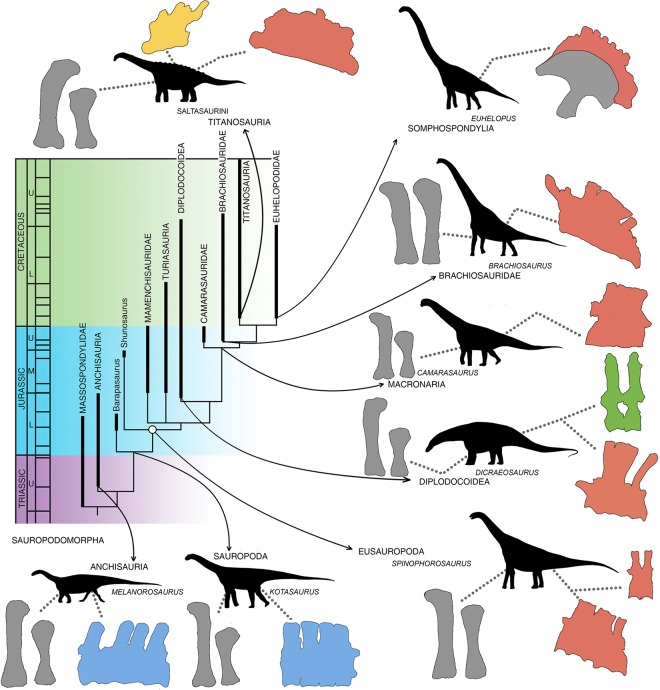Figure 3.
Time calibrated sauropodomorph phylogenetic relationships with emphasis on different body proportioned taxa. Different body proportions for sauropodomorph dinosaurs include (1) facultative quadrupedalism and medium height browsing in non-sauropod sauropodomorphs (e.g. Melanorosaurus) with non-wedged sacrum; (2) obligatory quadrupedalism and medium height browsing in basally branching sauropods with longer forelimbs but no wedged sacrum (e.g. Kotasaurus); (3) medium-high browsing in non-neosauropod eusauropods, with longer necks and forelimbs and an acute wedged sacrum (e.g. Spinophorosaurus); (4) medium-ground level browsing in dicraeosaurid and rebbachisaurid diplodocoid sauropods, with short necks, shorter forelimbs than non-neosauropod sauropodomorphs but with acute wedged sacrum and obtuse wedged dorsal vertebrae (e.g. Dicraeosaurus); (5) medium-height browsing in basally branching macronarian sauropods, with a wedge shaped sacrum and retroverted pelvis (e.g. Camarasaurus); (6) extreme high browsing in brachiosaurid sauropods, with extremely elongated necks, humeri longer than femora and extremely wedged sacra (e.g. Brachiosaurus); (7) extreme high browsing in euhelopodid titanosauriforms, with extremely long necks and extremely wedged sacra (e.g. Euhelopus); and (8) medium-low browsing in some lithostrotian titanosaurs, with shorter forelimbs than other titanosaurs and titanosauriforms but still retaining a wedged sacrum and with obtuse wedged dorsal vertebrae (e.g. Saltasaurini). A wedged sacrum is only found in Eusauropoda, and albeit the degree of wedging varies among sauropods, it never returns to the basal condition. Schematic bones obtained directly from digitized 3D models, except in Melanorosaurus53, Kotasaurus39, Dicraeosaurus54,55 and Euhelopus56, where photographs were used as reference. Femora and humeri are proportioned to each other following Table 1. Schematic bone color coding: rectangular sacra (blue); acute wedged sacra (red); obtuse wedged mid-dorsal vertebrae (yellow and green). Time callibration of nodes after Xu et al.47.

